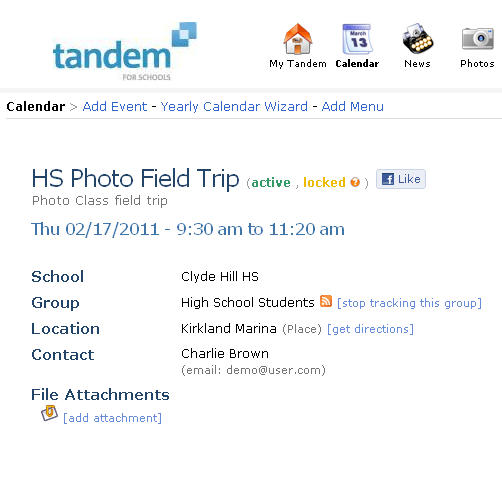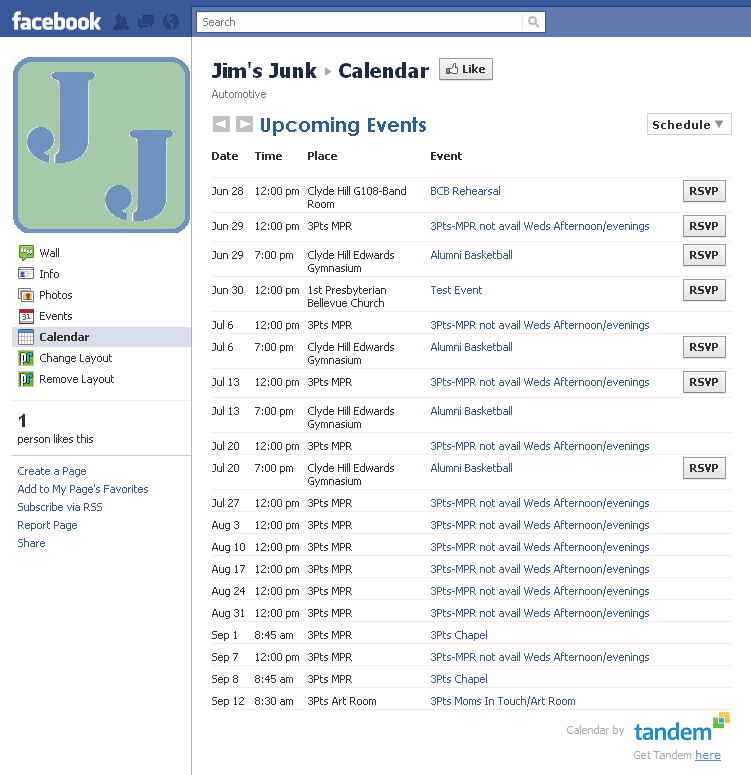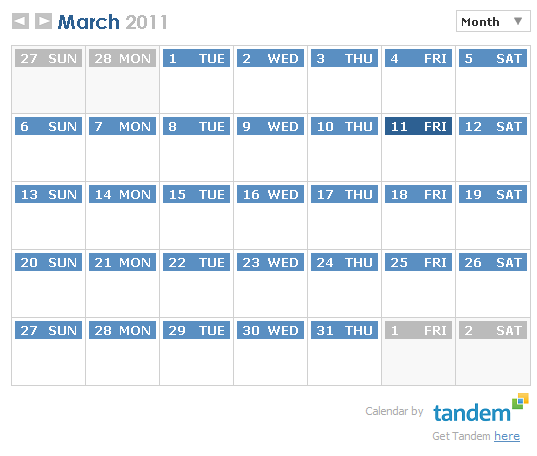Tandem Facebook App Update
The Tandem Facebook Application received an update today that allows it to utilize the Facebook RSVP system. With this update, users are now able to RSVP for events within the Tandem Facebook App. For schools and universities, thsi gives them the ability to create events in Tandem and easily be able to track attendees via the Dashboard in Tandem. Just another great feature we are giving are user to help grow strong communities!
Tandem Facebook App
A Facebook app is now available for EVERYONE to use on their Facebook page. It is a free app that displays your page’s events in a more user friendly way. To add the Tandem Calendar, log into Facebook and visit http://apps.facebook.com/tandemcal/. Here you will have the ability to add it to any Facebook page that you manage. It will then display like this on your Facbook page’s calendar tab:
Facebook “Like” Button
When viewing your event details within Tandem, you can now see how many people have liked that event in Facebook. A small Facebook “Like” button will now appear next to the event title. If you are interested in incorporating Tandem with your Facebook fan page, feel free to contact us and we will help you set that up. It is a relatively quick process and does not require much of your time.
Another big day at Intand! One of our more recognizable customers has had success integrating their Tandem calendar with their Facebook page. The integration between Tandem and Facebook is one of our newer features and we are extremely excited to see the University of Washington using this feature.
The new integration allows for a “Calendar” tab to be displayed at the top of their Facebook page. When displayed, it shows a list of events for the upcoming week that is pulled from their Tandem calendar. This integration also allows specific Facebook groups to be linked to a specific schedule of events within Tandem. For example, the Men’s Basket Ball group on Facebook will be able to sync with the Men’s Basket Ball schedule within Tandem (This feature will be displayed soon).
View the integration:
Using Facebook Fan Pages in Education
Alt hough it may seem like a diversion, and as something that could run counter to education, Facebook offers a number of ways in which to enhance educational goals. Facebook’s genesis was actually tied to education—it started its existence as a way for college students to stay connected to each other and has only relatively recently been opened up to the rest of the world.
hough it may seem like a diversion, and as something that could run counter to education, Facebook offers a number of ways in which to enhance educational goals. Facebook’s genesis was actually tied to education—it started its existence as a way for college students to stay connected to each other and has only relatively recently been opened up to the rest of the world.
Develop Connections In the School Community
Facebook can help provide a greater level of group cohesion by creating connections between individuals through common interests. Whether allowing teachers to get to know each other better, or students and parents to get to know each other better, the more each member of any group knows about the other members, the more likely they are to find and develop connections.
Facilitates Conversations In the School Community
A fan page can be an excellent place for school staff, parents, and students to engage in conversation. This can be anything from sharing excellent learning resources to getting feedback from parents and students about new school programs.
A fan page could also be created by teachers for a specific class. Students could post homework questions that other students could help with. Teachers and students could also post useful links or embed videos on the class fan page. However one drawback is that anyone can join a fan page. If you want more control over your community, a Facebook group may be a better option. Administrators of a group can manage who is allowed into the group.
Also Facebook requires users be at least 13 years of age. So students in lower grade levels will not be able to participate. For these grade levels, a classroom blog may be a better tool.
Using Facebook In Education
While the thought of Facebook as a learni ng tool might elicit some skepticism, savvy students are discovering uses for the ubiquitous social media site beyond trading gossip and playing games. In fact, Facebook offers an array of applications geared to student needs. Web tools like Do Research 4 Me, Wikiseek Search, and JSTOR Search take the tedium and legwork out of researching term papers. Applications are available for homework assistance, forming virtual study groups, finding the best deals on textbooks, and of course Rate My Professors.
ng tool might elicit some skepticism, savvy students are discovering uses for the ubiquitous social media site beyond trading gossip and playing games. In fact, Facebook offers an array of applications geared to student needs. Web tools like Do Research 4 Me, Wikiseek Search, and JSTOR Search take the tedium and legwork out of researching term papers. Applications are available for homework assistance, forming virtual study groups, finding the best deals on textbooks, and of course Rate My Professors.
Teachers are getting aboard the Facebook bandwagon and establishing accounts of their own, finding it an effective bridge beyond the classroom, freeing them of late night calls from frantic pupils and parents seeking last-minute information on the week’s spelling words or a project due the next day. Facebook also fills a crucial gap as a forum for providing homework guidance and lesson-extending tutorials that may be lacking for latch-key kids. When Facebook is integrated into the learning environment, it helps create a safe online community that parents can feel confident about.
Facebook even provides opportunities for parent involvement through online interaction in a platform that is flexible enough to fit even the busiest schedule. As a conduit for communication it helps build teacher-student-parent relationships beyond the constraints of classroom walls and school schedules, and it does so in a way that is non-intrusive and non-threatening. A parent who dreads the idea of attending a parent-teacher conference after a long day of work and putting a meal on the family table is likely to relish being able to conduct a meeting at their fingertips. In this manner, Facebook creates new opportunities for dialogue between teachers, parents and students, spanning generational, geographic, and cultural distances. When students see that teachers are willing to “speak their language” and use the tools of their generation, amazing connections can occur.
Do you think Facebook has a role in education? Leave your comments below.
Social Networking is Not Going Away
With over 80 million users on MySpace alone, social networking is not going away. And that National School Boards Association report said that 50% of students using these services are specifically talking about schoolwork using these social networking tools.
There is a compelling article at TechLearning.com discussing the proliferation of social networks amongst kids. Of course, much of the press has been bad — cyberstalking, online porn, etc., etc. But, social networking is not going away. And kids are definitely using tools like MySpace and Facebook to keep connected. The above stat is huge: 50% of kids use social networks to chat about homework.
So then, how can it be used to keep kids, and parents, connected to the school community? And how can it be used to drive higher participation? These are huge questions. And we are working hard to try and answer them.
Imagine school events being added to calendars which then automatically feed the information to students on Facebook or MySpace. Students use these sites incessantly, much to the chagrin of parents. And parents should be discerning. But we’d love to help schools use these technologies for the benefit of the school community, which will hopefully filter out the bad.

